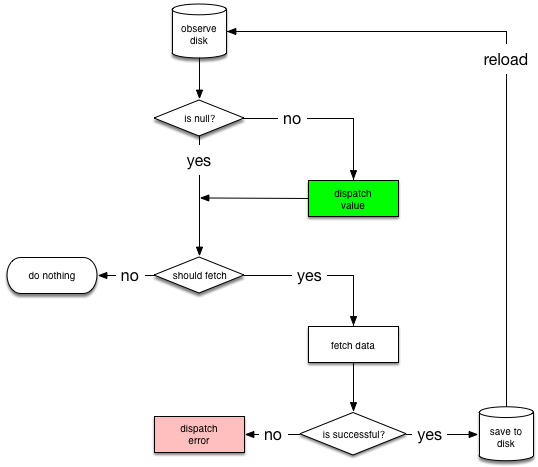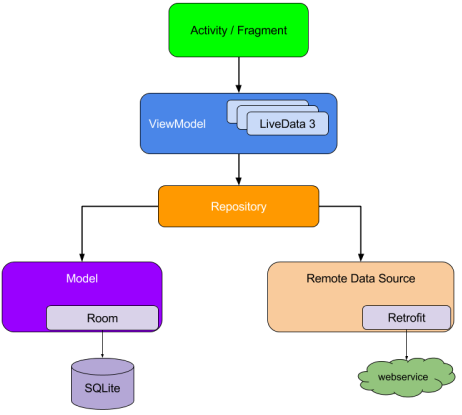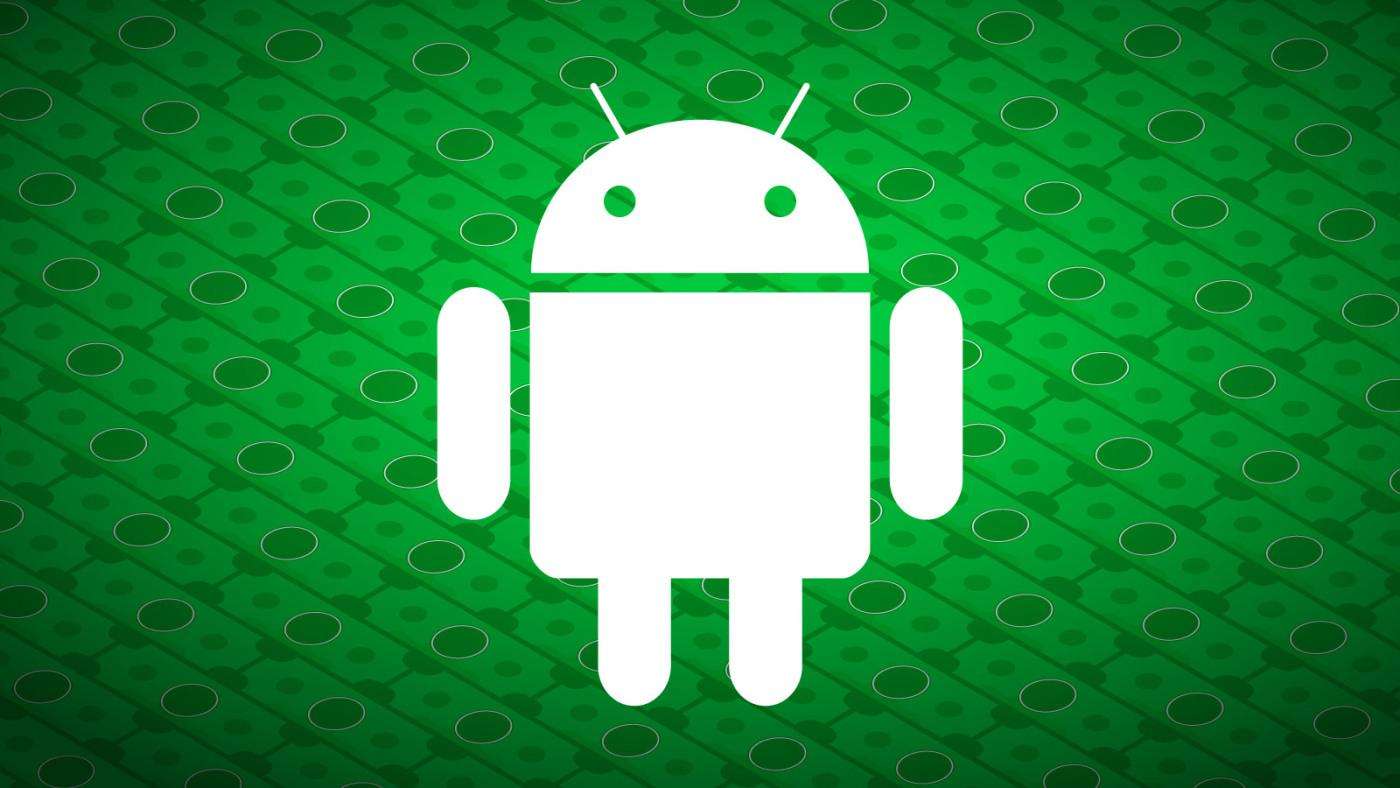Google 官方推出应用开发架构指南
简评:虽然说 Android 的架构选择一直都很自由,MVP、MVC、MVVM 各有拥趸。但 Google 最近还是推出了一份关于应用架构的实践指南,并给出了相当详尽的步骤和一些指导建议。希望大家都能看一看,学习一下,打造更加优秀易用的 APP,也为 Android 生态的改善做一点贡献。: )
最近,官方推出了一份关于应用架构的最佳实践指南。这里就给大家简要介绍一下:
首先,Android 开发者肯定都知道 Android 中有四大组件,这些组件都有各自的生命周期并且在一定程度上是不受你控制的。在任何时候,Android 操作系统都可能根据用户的行为或资源紧张等原因回收掉这些组件。
这也就引出了第一条准则:「不要在应用程序组件中保存任何应用数据或状态,并且组件间也不应该相互依赖」。
最常见的错误就是在 Activity 或 Fragment 中写了与 UI 和交互无关的代码。尽可能减少对它们的依赖,这能避免大量生命周期导致的问题,以提供更好的用户体验。
第二条准则:「通过 model 驱动应用 UI,并尽可能的持久化」。
这样做主要有两个原因:
1、如果系统回收了你的应用资源或其他什么意外情况,不会导致用户丢失数据。
2、Model 就应该是负责处理应用程序数据的组件。独立于视图和应用程序组件,保持了视图代码的简单,也让你的应用逻辑更容易管理。并且,将应用数据置于 model 类中,也更有利于测试。
官方推荐的 App 架构
在这里,官方演示了通过使用最新推出的 Architecture Components 来构建一个应用。
想象一下,您正在打算开发一个显示用户个人信息的界面,用户数据通过 REST API 从后端获取。
首先,我们需要创建三个文件:
user_profile.xml:定义界面。
UserProfileViewModel.java:数据类。
UserProfileFragment.java:显示 ViewModel 中的数据并对用户的交互做出反应。
为了简单起见,我们这里就省略掉布局文件。
代码
public class UserProfileViewModel extends ViewModel {
private String userId;
private User user;
public void init(String userId) {
this.userId = userId;
}
public User getUser() {
return user;
}
} 代码
public class UserProfileFragment extends LifecycleFragment {
private static final String UID_KEY = "uid";
private UserProfileViewModel viewModel;
@Override
public void onActivityCreated(@Nullable Bundle savedInstanceState) {
super.onActivityCreated(savedInstanceState);
String userId = getArguments().getString(UID_KEY);
viewModel = ViewModelProviders.of(this).get(UserProfileViewModel.class);
viewModel.init(userId);
}
@Override
public View onCreateView(LayoutInflater inflater,
@Nullable ViewGroup container, @Nullable Bundle savedInstanceState) {
return inflater.inflate(R.layout.user_profile, container, false);
}
} 注意其中的 ViewModel 和 LifecycleFragment 都是 Android 新引入的,可以参考官方说明进行集成。
现在,我们完成了这三个模块,该如何将它们联系起来呢?也就是当 ViewModel 中的用户字段被设置时,我们需要一种方法来通知 UI。这就是 LiveData 的用武之地了。
引用
LiveData 是一个可被观察的数据持有者(用到了观察者模式)。其能够允许 Activity, Fragment 等应用程序组件对其进行观察,并且不会在它们之间创建强依赖。LiveData 还能够自动响应各组件的声明周期事件,防止内存泄漏,从而使应用程序不会消耗更多的内存。
注意: LiveData 和 RxJava 或 Agera 的区别主要在于 LiveData 自动帮助处理了生命周期事件,避免了内存泄漏。
所以,现在我们来修改一下 UserProfileViewModel:
代码
public class UserProfileViewModel extends ViewModel {
...
private LiveData<User> user;
public LiveData<User> getUser() {
return user;
}
} 再在 UserProfileFragment 中对其进行观察并更新我们的 UI:代码
@Override
public void onActivityCreated(@Nullable Bundle savedInstanceState) {
super.onActivityCreated(savedInstanceState);
viewModel.getUser().observe(this, user -> {
// update UI
});
}
获取数据
现在,我们联系了 ViewModel 和 Fragment,但 ViewModel 又怎么来获取到数据呢?
在这个示例中,我们假定后端提供了 REST API,因此我们选用 Retrofit 来访问我们的后端。
首先,定义一个 Webservice:
代码
public interface Webservice {
/**
* @GET declares an HTTP GET request
* @Path("user") annotation on the userId parameter marks it as a
* replacement for the {user} placeholder in the @GET path
*/
@GET("/users/{user}")
Call<User> getUser(@Path("user") String userId);
}
不要通过 ViewModel 直接来获取数据,这里我们将工作转交给一个新的 Repository 模块。
引用
Repository 模块负责数据处理,为应用的其他部分提供干净可靠的 API。你可以将其考虑为不同数据源(Web,缓存或数据库)与应用之间的中间层。
代码
public class UserRepository {
private Webservice webservice;
// ...
public LiveData<User> getUser(int userId) {
// This is not an optimal implementation, we'll fix it below
final MutableLiveData<User> data = new MutableLiveData<>();
webservice.getUser(userId).enqueue(new Callback<User>() {
@Override
public void onResponse(Call<User> call, Response<User> response) {
// error case is left out for brevity
data.setValue(response.body());
}
});
return data;
}
} 管理组件间的依赖关系
根据上面的代码,我们可以看到 UserRepository 中有一个 Webservice 的实例,不要直接在 UserRepository 中 new 一个 Webservice。这很容易导致代码的重复与复杂化,比如 UserRepository 很可能不是唯一用到 Webservice 的类,如果每个用到的类都新建一个 Webservice,这显示会导致资源的浪费。
这里,我们推荐使用 Dagger 2 来管理这些依赖关系。
现在,让我们来把 ViewModel 和 Repository 连接起来吧:
代码
public class UserProfileViewModel extends ViewModel {
private LiveData<User> user;
private UserRepository userRepo;
@Inject // UserRepository parameter is provided by Dagger 2
public UserProfileViewModel(UserRepository userRepo) {
this.userRepo = userRepo;
}
public void init(String userId) {
if (this.user != null) {
// ViewModel is created per Fragment so
// we know the userId won't change
return;
}
user = userRepo.getUser(userId);
}
public LiveData<User> getUser() {
return this.user;
}
} 缓存数据
在实际项目中,Repository 往往不会只有一个数据源。因此,我们这里在其中再加入缓存:
代码
@Singleton // informs Dagger that this class should be constructed once
public class UserRepository {
private Webservice webservice;
// simple in memory cache, details omitted for brevity
private UserCache userCache;
public LiveData<User> getUser(String userId) {
LiveData<User> cached = userCache.get(userId);
if (cached != null) {
return cached;
}
final MutableLiveData<User> data = new MutableLiveData<>();
userCache.put(userId, data);
// this is still suboptimal but better than before.
// a complete implementation must also handle the error cases.
webservice.getUser(userId).enqueue(new Callback<User>() {
@Override
public void onResponse(Call<User> call, Response<User> response) {
data.setValue(response.body());
}
});
return data;
}
}
持久化数据
现在当用户旋转屏幕或暂时离开应用再回来时,数据是直接可见的,因为是直接从缓存中获取的数据。但要是用户长时间关闭应用,并且 Android 还彻底杀死了进程呢?
我们目前的实现中,会再次从网络中获取数据。这可不是一个好的用户体验。这时就需要数据持久化了。继续引入一个新组件 Room。
引用
Room 能帮助我们方便的实现本地数据持久化,抽象出了很多常用的数据库操作,并且在编译时会验证每个查询,从而损坏的 SQL 查询只会导致编译时错误,而不是运行时崩溃。还能和上面介绍的 LiveData 完美合作,并帮开发者处理了很多线程问题。
现在,让我们来看看怎么使用 Room 吧。: )
首先,在 User 类上面加上 @Entity,将 User 声明为你数据库中的一张表。
代码
@Entity
class User {
@PrimaryKey
private int id;
private String name;
private String lastName;
// getters and setters for fields
}
再创建数据库类并继承 RoomDatabase:
代码
@Database(entities = {User.class}, version = 1)
public abstract class MyDatabase extends RoomDatabase {
} 注意 MyDatabase 是一个抽象类,Room 会自动添加实现的。
现在我们需要一种方法来将用户数据插入到数据库:
代码
@Dao
public interface UserDao {
@Insert(onConflict = REPLACE)
void save(User user);
@Query("SELECT * FROM user WHERE id = :userId")
LiveData<User> load(String userId);
}
再在数据库类中加入 DAO:
代码
@Database(entities = {User.class}, version = 1)
public abstract class MyDatabase extends RoomDatabase {
public abstract UserDao userDao();
} 注意上面的 load 方法返回的是 LiveData,Room 会知道什么时候数据库发生了变化并自动通知所有的观察者。这也就是 LiveData 和 Room 搭配的妙用。 现在继续修改 UserRepository:
代码
@Singleton
public class UserRepository {
private final Webservice webservice;
private final UserDao userDao;
private final Executor executor;
@Inject
public UserRepository(Webservice webservice, UserDao userDao, Executor executor) {
this.webservice = webservice;
this.userDao = userDao;
this.executor = executor;
}
public LiveData<User> getUser(String userId) {
refreshUser(userId);
// return a LiveData directly from the database.
return userDao.load(userId);
}
private void refreshUser(final String userId) {
executor.execute(() -> {
// running in a background thread
// check if user was fetched recently
boolean userExists = userDao.hasUser(FRESH_TIMEOUT);
if (!userExists) {
// refresh the data
Response response = webservice.getUser(userId).execute();
// TODO check for error etc.
// Update the database.The LiveData will automatically refresh so
// we don't need to do anything else here besides updating the database
userDao.save(response.body());
}
});
}
}
可以看到,即使我们更改了 UserRepository 中的数据源,我们也完全不需要修改 ViewModel 和 Fragment,这就是抽象的好处。同时还非常适合测试,我们可以在测试 UserProfileViewModel 时提供测试用的 UserRepository。
引用
下面部分的内容在原文中是作为附录,但我个人觉得也很重要,所以擅自挪上来,一起为大家介绍了。: )
在上面的例子中,有心的大家可能发现了我们没有处理网络错误和正在加载状态。但在实际开发中其实是很重要的。这里,我们就实现一个工具类来根据不同的网络状况选择不同的数据源。
首先,实现一个 Resource 类:
代码
//a generic class that describes a data with a status
public class Resource<T> {
@NonNull public final Status status;
@Nullable public final T data;
@Nullable public final String message;
private Resource(@NonNull Status status, @Nullable T data, @Nullable String message) {
this.status = status;
this.data = data;
this.message = message;
}
public static <T> Resource<T> success(@NonNull T data) {
return new Resource<>(SUCCESS, data, null);
}
public static <T> Resource<T> error(String msg, @Nullable T data) {
return new Resource<>(ERROR, data, msg);
}
public static <T> Resource<T> loading(@Nullable T data) {
return new Resource<>(LOADING, data, null);
}
}
因为,从网络加载数据和从磁盘加载是很相似的,所以再新建一个 NetworkBoundResource 类,方便多处复用。下面是 NetworkBoundResource 的决策树:

API 设计:
代码
// ResultType: Type for the Resource data
// RequestType: Type for the API response
public abstract class NetworkBoundResource<ResultType, RequestType> {
// Called to save the result of the API response into the database
@WorkerThread
protected abstract void saveCallResult(@NonNull RequestType item);
// Called with the data in the database to decide whether it should be
// fetched from the network.
@MainThread
protected abstract boolean shouldFetch(@Nullable ResultType data);
// Called to get the cached data from the database
@NonNull @MainThread
protected abstract LiveData<ResultType> loadFromDb();
// Called to create the API call.
@NonNull @MainThread
protected abstract LiveData<ApiResponse<RequestType>> createCall();
// Called when the fetch fails. The child class may want to reset components
// like rate limiter.
@MainThread
protected void onFetchFailed() {
}
// returns a LiveData that represents the resource
public final LiveData<Resource<ResultType>> getAsLiveData() {
return result;
}
}
注意上面使用了 ApiResponse 作为网络请求, ApiResponse 是对于 Retrofit2.Call 的简单包装,用于将其响应转换为 LiveData。
下面是具体的实现:
代码
public abstract class NetworkBoundResource<ResultType, RequestType> {
private final MediatorLiveData<Resource<ResultType>> result = new MediatorLiveData<>();
@MainThread
NetworkBoundResource() {
result.setValue(Resource.loading(null));
LiveData<ResultType> dbSource = loadFromDb();
result.addSource(dbSource, data -> {
result.removeSource(dbSource);
if (shouldFetch(data)) {
fetchFromNetwork(dbSource);
} else {
result.addSource(dbSource,
newData -> result.setValue(Resource.success(newData)));
}
});
}
private void fetchFromNetwork(final LiveData<ResultType> dbSource) {
LiveData<ApiResponse<RequestType>> apiResponse = createCall();
// we re-attach dbSource as a new source,
// it will dispatch its latest value quickly
result.addSource(dbSource,
newData -> result.setValue(Resource.loading(newData)));
result.addSource(apiResponse, response -> {
result.removeSource(apiResponse);
result.removeSource(dbSource);
//noinspection ConstantConditions
if (response.isSuccessful()) {
saveResultAndReInit(response);
} else {
onFetchFailed();
result.addSource(dbSource,
newData -> result.setValue(
Resource.error(response.errorMessage, newData)));
}
});
}
@MainThread
private void saveResultAndReInit(ApiResponse<RequestType> response) {
new AsyncTask<Void, Void, Void>() {
@Override
protected Void doInBackground(Void... voids) {
saveCallResult(response.body);
return null;
}
@Override
protected void onPostExecute(Void aVoid) {
// we specially request a new live data,
// otherwise we will get immediately last cached value,
// which may not be updated with latest results received from network.
result.addSource(loadFromDb(),
newData -> result.setValue(Resource.success(newData)));
}
}.execute();
}
}
现在,我们就能使用 NetworkBoundResource 来根据不同的情况获取数据了:
代码
class UserRepository {
Webservice webservice;
UserDao userDao;
public LiveData<Resource<User>> loadUser(final String userId) {
return new NetworkBoundResource<User,User>() {
@Override
protected void saveCallResult(@NonNull User item) {
userDao.insert(item);
}
@Override
protected boolean shouldFetch(@Nullable User data) {
return rateLimiter.canFetch(userId) && (data == null || !isFresh(data));
}
@NonNull @Override
protected LiveData<User> loadFromDb() {
return userDao.load(userId);
}
@NonNull @Override
protected LiveData<ApiResponse<User>> createCall() {
return webservice.getUser(userId);
}
}.getAsLiveData();
}
} 到这里,我们的代码就全部完成了。最后的架构看起来就像这样:

最后的最后,给出一些指导原则
下面的原则虽然不是强制性的,但根据我们的经验遵循它们能使您的代码更健壮、可测试和可维护的。
所有您在 manifest 中定义的组件 - activity, service, broadcast receiver… 都不是数据源。因为每个组件的生命周期都相当短,并取决于当前用户与设备的交互和系统的运行状况。简单来说,这些组件都不应当作为应用的数据源。
在您应用的各个模块之间建立明确的责任边界。比如,不要将与数据缓存无关的代码放在同一个类中。
每个模块尽可能少的暴露内部实现。从过去的经验来看,千万不要为了一时的方便而直接将大量的内部实现暴露出去。这会让你在以后承担很重的技术债务(很难更换新技术)。
在您定义模块间交互时,请考虑如何使每个模块尽量隔离,通过设计良好的 API 来进行交互。
您应用的核心应该是能让它脱颖而出的某些东西。不要浪费时间重复造轮子或一次次编写同样的模板代码。相反,应当集中精力在使您的应用独一无二,而将一些重复的工作交给这里介绍的 Android Architecture Components 或其他优秀的库。
尽可能持久化数据,以便您的应用在脱机模式下依然可用。虽然您可能享受着快捷的网络,但您的用户可能不会。
引用
另外,Kotlin 版本的多个官方 Sample 也公布啦,感兴趣的同学赶紧去看看吧:Android Kotlin Samples
原文:Guide to App Architecture
本篇文章为 @ 21CTO 创作并授权 21CTO 发布,未经许可,请勿转载。
内容授权事宜请您联系 webmaster@21cto.com或关注 21CTO 公众号。
该文观点仅代表作者本人,21CTO 平台仅提供信息存储空间服务。
